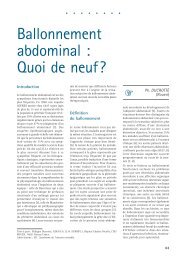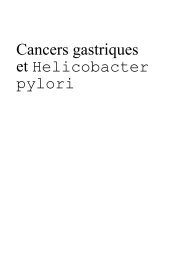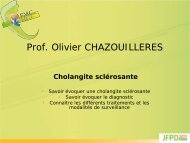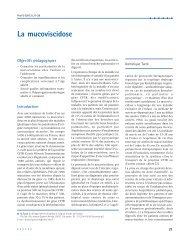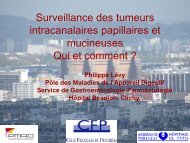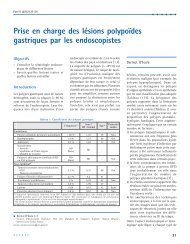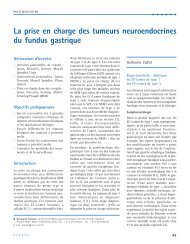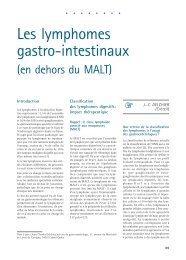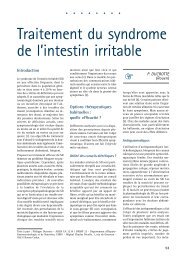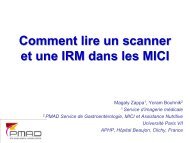Facteurs de risque du cancer du pancréas - FMC-HGE
Facteurs de risque du cancer du pancréas - FMC-HGE
Facteurs de risque du cancer du pancréas - FMC-HGE
Create successful ePaper yourself
Turn your PDF publications into a flip-book with our unique Google optimized e-Paper software.
Louis BUSCAIL<br />
<strong>Facteurs</strong> <strong>de</strong> <strong>risque</strong> <strong>du</strong> <strong>cancer</strong> <strong>du</strong> <strong>pancréas</strong><br />
• Connaître les facteurs <strong>de</strong> <strong>risque</strong> environnementaux.<br />
• Connaître les facteurs <strong>de</strong> <strong>risque</strong> familiaux.<br />
• Connaître les lésions pré-cancéreuses.<br />
• Savoir qui surveiller et comment.
LES FACTEURS DE RISQUE<br />
DU CANCER DU PANCREAS<br />
Pr Louis Buscail<br />
<strong>FMC</strong> <strong>HGE</strong> - 18 Mars 2006<br />
Service <strong>de</strong> Gastro-entérologie et Nutrition - INSERM U531<br />
CHU Rangueil - TOULOUSE
LE CANCER<br />
Adénocarcinome peu différencié dans 95% <strong>de</strong>s cas<br />
69 – 74 ans / sex ratio 1,5-2<br />
Envahissement précoce:<br />
- ganglions & nerfs<br />
- péritoine<br />
- foie<br />
Survie < 3 % à 5 ans
LE PRONOSTIC<br />
Traitement<br />
Palliatif<br />
CHU Toulouse Rangueil 1992-2002<br />
Chirurgie curative (12%)<br />
17 mois<br />
6 mois<br />
Survie médiane ( mois )<br />
(Buscail et al. Gastrointest Endosc 1999; Escourrou et al. GCB 2003)
COMMENT AMELIORER CE PRONOSTIC ?<br />
- Prévention = impact sur les facteurs <strong>de</strong> <strong>risque</strong>s<br />
- Diagnostic précoce<br />
= dépistage<br />
= population à <strong>risque</strong><br />
= lésion(s) pré-cancéreuse(s)<br />
- Meilleur(s) traitement(s)<br />
« Marqueur fiable »
100 000<br />
Année<br />
L’INCIDENCE DANS LE MONDE ( 1 )<br />
7,4<br />
7,3 9<br />
7,4<br />
6,2 8,6<br />
7,2<br />
5,4<br />
2,4<br />
1,8<br />
7,9<br />
9,5<br />
10,7<br />
1,4<br />
4,8<br />
7,5
100 000<br />
Année<br />
L’INCIDENCE DANS LE MONDE ( 2 )<br />
6,8<br />
8/10,5<br />
7,3<br />
8,5/12,9<br />
8,2<br />
7,5<br />
8,6<br />
9,1/9,2<br />
7,4/10,5<br />
6,2<br />
5,8
100 000<br />
Année<br />
L’INCIDENCE DANS LE MONDE ( 3 )<br />
2,1<br />
1<br />
5,4<br />
6,3 - 7<br />
2<br />
4,7<br />
10,9
100 000<br />
Année<br />
8<br />
7<br />
6<br />
5<br />
4<br />
3<br />
2<br />
1<br />
L’INCIDENCE EN FRANCE<br />
Hommes Femmes<br />
1980 1985 1990 1995 2000
100 000<br />
Année<br />
8<br />
7<br />
6<br />
5<br />
4<br />
3<br />
2<br />
1<br />
LA MORTALITE EN FRANCE<br />
Hommes Femmes<br />
1980 1985 1990 1995 2000
LES CHIFFRES COMPARATIFS EN FRANCE<br />
http://www.sante.gouv.fr/<br />
Inci<strong>de</strong>nce (10 5 )<br />
Sein: 80<br />
Prostate: 54<br />
Colon-rectum: 24-37<br />
Poumon: 7 - 51<br />
ORL: 1,8 - 21<br />
Vessie: 1,2 - 17<br />
14 ième<br />
http://ligue-<strong>cancer</strong>.asso.fr/<br />
Mortalité<br />
Poumon: 27 164<br />
Colon-rectum: 15 973<br />
Sein: 11 637<br />
Prostate: 10 040<br />
Foie: 7 856<br />
Pancréas: 7 191<br />
6 ième
FACTEURS DE RISQUES ENVIRONNEMENTAUX (1)<br />
LA NUTRITION<br />
« Développement socio-économique élevé »<br />
- Régime hypercalorique, cholestérol, vian<strong>de</strong>s rouges<br />
- Obésité<br />
- Déficit en exercice physique<br />
- Pauvre en fibres, vitamines, antioxydants<br />
(fruits et légumes)
FACTEURS DE RISQUES ENVIRONNEMENTAUX (2)<br />
LE TABAC, L’ALCOOL ET LE CAFE<br />
- Tabac = <strong>risque</strong> relatif 1,7 à 3,8<br />
(nitrosamines)<br />
- Alcool= pas <strong>de</strong> sur-<strong>risque</strong><br />
- Café = presque pas <strong>de</strong> sur-<strong>risque</strong><br />
LES SUBSTANCES TOXIQUES<br />
- Hydrocarbures aromatiques<br />
- Insectici<strong>de</strong>s organophosphorés<br />
- In<strong>du</strong>strie pétrochimique, métallurgie, scieries
MALADIES FAVORISANTES<br />
LE DIABETE<br />
Il est présent au moment <strong>du</strong> diagnostic dans 40 à 60 % <strong>de</strong>s cas<br />
« conséquence ou cause ? »<br />
- Islet Amyloid Polypepti<strong>de</strong> = facteur d’insulinorésistance<br />
« <strong>cancer</strong> <strong>du</strong> <strong>pancréas</strong> seulement responsable <strong>de</strong> 5%<br />
<strong>de</strong>s diabètes tardifs »<br />
(Gullo L. N Eng J Med Jul 1994; Damiano L. Diabetes Metab 2004)<br />
- Diabète <strong>de</strong> plus <strong>de</strong> 10 ans: <strong>risque</strong> relatif 1,6 à 2,8<br />
« physiopathologie inconnue, impact clinique faible »<br />
(Everhart J. JAMA 1995; Gapstur SM. JAMA 2000)
FACTEURS FAMILIAUX<br />
LE SYNDROME DU CANCER FAMILIAL<br />
- Deux cas chez parents au premier <strong>de</strong>gré<br />
- 5% <strong>de</strong>s <strong>cancer</strong>s pancréatiques<br />
- Autosomique dominante<br />
- Pas <strong>de</strong> gène, pas <strong>de</strong> recommandations<br />
AUTRES MALADIES GENETIQUES<br />
- Syndrome <strong>de</strong> Peutz-Jeghers (x 25)<br />
- BRCA2 (x 10), FAMM, HNPCC
PanIN<br />
Hruban RH et al. Am J Pathol 2000<br />
LESIONS PRE-CANCEREUSES ( 1 )<br />
Papillary <strong>du</strong>ctal<br />
hyperplasia<br />
Papillary <strong>du</strong>ctal<br />
Hyperplasia and atypia<br />
In situ<br />
carcinoma<br />
(Redston M.S. Cancer. Res. 1994; Caldas C. Nat. Genet. 1994; Konishi Y. Pancreas 1998)
- TIPMP<br />
LESIONS PRE-CANCEREUSES ( 2 )<br />
TUMEURS MUCINEUSES<br />
- canaux II: 15 % à 5 ans<br />
- canal I ou mixtes: 45 % à 5 ans<br />
- CYSTADENOMES MUCINEUX = 50%
LESIONS PRE-CANCEREUSES ( 3 )<br />
LA PANCREATITE CHRONIQUE CALCIFIANTE (5%)<br />
- Alcoolique: <strong>risque</strong> relatif = 1,8 à 2 à 10 ans d’évolution<br />
- PC Familiale <strong>risque</strong> plus élevé<br />
Rôle <strong>de</strong> l’alcool ? Rôle <strong>de</strong> l’inflammation ? Du tabac ?<br />
GAPDH 380 pb<br />
exon 11 DPC4 296 pb<br />
exon 9 DPC4 254 pb<br />
PCR multiplex<br />
PN B T M T PN B<br />
Cancer PCC<br />
K- ras 70% 10%<br />
p16/MTS1 31% 42%<br />
DPC4 44% 47%<br />
355 pb DPC4 exon 8<br />
293 pb DPC4 exon 10<br />
156 pb K-ras<br />
( Berthelémy et al. Annals Int Med 1996; Constentin L et al. Pancreatology, 2002)
QUI ET COMMENT SURVEILLER ?<br />
- LES TUMEURS MUCINEUSES = OPERER…<br />
Diagnostic pré-opératoire <strong>de</strong> nature et <strong>de</strong> malignité<br />
« critères radiologiques et cytoponction »<br />
- PANCREATITE CHRONIQUE: DIAGNOSTIC DIFFICILE<br />
« Ictère avec prurit » ou « douleurs après une phase muette »<br />
Rôle <strong>de</strong> la cytoponction sous échoendoscopie ?!<br />
- FORME FAMILIALE<br />
Scanner multibarettes et/ou échoendoscopie ? (Johns Hopkins Data)
AUTRES SITUATIONS PRATIQUES<br />
- LA PANCREATITE AIGUE<br />
IDIOPATHIQUE<br />
- peut cacher un petit adénocarcinome<br />
- révèle souvent une TIPMP<br />
à un sta<strong>de</strong> utile …<br />
- UN DIABETE A PLUS DE 50 ANS SANS OBESITE OU<br />
ANTECEDENTS FAMILIAUX AVEC SYMPTOMES<br />
ABDOMINAUX ET/OU PERTE DE POIDS<br />
Scanner multibarettes !!
CONCLUSIONS<br />
- AUGMENTATION D’INCIDENCE<br />
- PAS DE « SITUATIONS A RISQUE » EVIDENTES<br />
- PAS DE MOYEN DE DEPISTAGE NI MARQUEURS<br />
- LESIONS PRE-CANCEREUSES A CONNAÎTRE<br />
ET SURTOUT A RECONNAÎTRE…<br />
- PAS DE PREVENTION… sauf<br />
« ne pas fumer, faire <strong>de</strong> l’exercice, manger équilibré »



